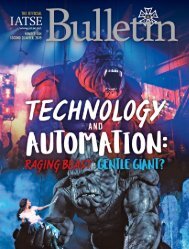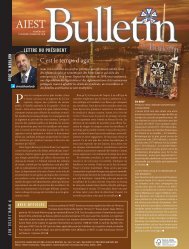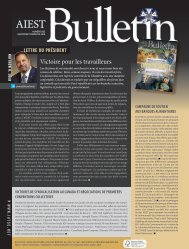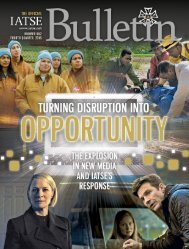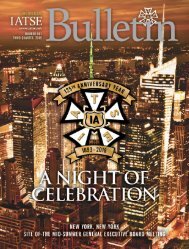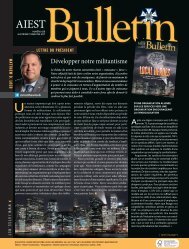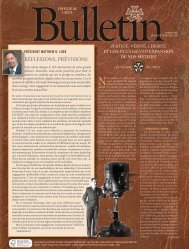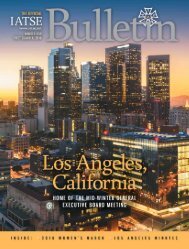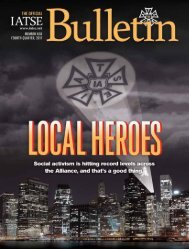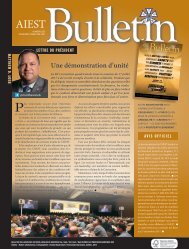IATSE-2nd2018_web
You also want an ePaper? Increase the reach of your titles
YUMPU automatically turns print PDFs into web optimized ePapers that Google loves.
attlefield the next day, this time armed with an injunction<br />
from a Superior Court judge that barred the police from<br />
interfering with the strike. Warner Brothers got its own<br />
injunction limiting the number of picketers to no more than<br />
three at a gate.<br />
The following week, violence again broke out at Warner. This<br />
time people came armed with some sort of weapon. Thirty-nine<br />
people were injured. Many Warner workers who had managed<br />
to get through the picket lines stayed inside the studio that<br />
night. Others were brought in during the middle of the night.<br />
The violence continued throughout the week, although not as<br />
brutally as in the first days.<br />
On October 11, three hundred picketerts were arrested<br />
and jailed for violent conduct on the picket line. The public<br />
was now paying close attention and there was increasing<br />
pressure to settle matters. The NLRB was finally forced to<br />
make a decision: Who would represent the set decorators, the<br />
CSU or the IA?<br />
The NLRB decided that votes of both the strikers and their<br />
replacements would be counted. The tally was 55 to 45 in favor<br />
of the CSU. Despite this vote, neither the strike nor the violence<br />
ended due to other jurisdictional arguments that had grown out<br />
of the conflict.<br />
After six more months of struggle, a meeting in Cincinnati<br />
was called between the producers and the unions. While they<br />
were meeting, the mass picketing and violence spread to several<br />
other large studios, including RKO, Paramount and Republic.<br />
A settlement of sorts was reached in Cincinnati. The strike<br />
would end and a 30-day period of negotiations would be held on<br />
all jurisdictional issues. All strikers would return to their former<br />
jobs and replacements would be given sixty days severance pay.<br />
The committee awarded set erection to <strong>IATSE</strong> Local 80, which<br />
had been founded in 1939 to represent motion picture grips (it<br />
now also represents craft service, marine, first aid employees,<br />
and warehouse workers). It based this decision primarily on a<br />
1925 settlement between the IA and the Carpenters that led to<br />
the Studio Basic Agreement. The matters not settled during this<br />
time would be worked out by a three-member committee drawn<br />
from the AFL Executive Council. Their eventual decision would<br />
be the cause of the next long and bitter internal labor dispute<br />
and strike.<br />
THE LAST GREAT STRUGGLE<br />
In January 1946, members of Carpenters Local 946 staged<br />
sit-ins at Universal and Columbia to protest the AFL committee’s<br />
decision. Pressured by the Carpenters’ “Big Bill” Hutcheson, AFL<br />
President William Green then issued a statement calling for a<br />
“clarification” of the committee’s decision.<br />
Carpenters Local 946 then joined the CSU, substantially<br />
increasing the number of workers in the Conference. The<br />
producers were given an ultimatum: increase pay and adjust<br />
hours to provide work for returning veterans or face a major<br />
strike. Negotiations quickly broke down. A short time later,<br />
fights over the various jurisdictional problems — Painters and<br />
Carpenters versus IA grips, for example — were leading to<br />
layoffs of hundreds of workers .<br />
Finally, in the summer of 1946, CSU members walked off<br />
the job. At this point, an agreement, known as the “Treaty of<br />
Beverly Hills,” was reached in which the strikers returned to work<br />
and all workers received a 25 percent wage increase and a 36-<br />
hour work week.<br />
THE DEATH OF THE CSU<br />
At long last, the AFL three-person committee on jurisdictional<br />
disputes in Hollywood issued its “clarification” of the set erection<br />
issue, awarding construction to the Carpenters and assembly to<br />
the <strong>IATSE</strong>, essentially reversing the 1945 ruling that supported the<br />
IA’s position. Subsequently, under continuing pressure from the<br />
37




